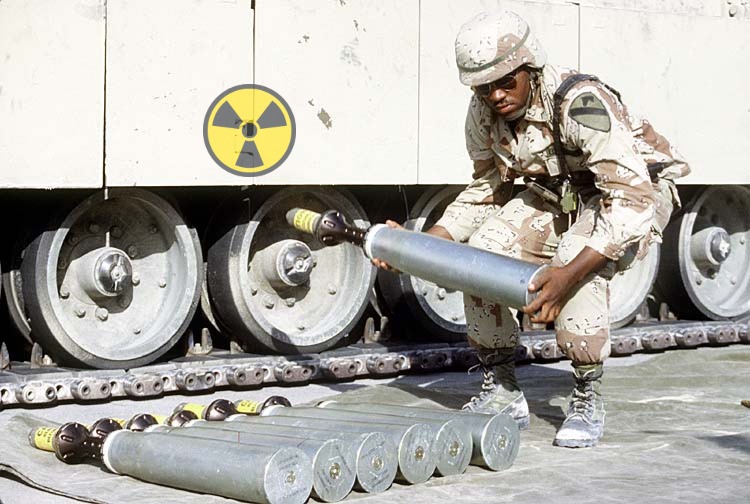Veterans Exposed to Depleted Uranium and VA Benefits

CCK Law: Our Vital Role in Veterans Law
What is Depleted Uranium?
Depleted uranium results from the process of manufacturing enriched uranium (used in nuclear reactors or weapons) from natural uranium (found in the Earth’s crust). During this process, some of the radioactivity from the natural uranium is removed in order to concentrate it for the “enriched” product. Specifically, the remaining uranium (i.e. depleted uranium) is “depleted” of about 40 percent of its radioactivity. Nonetheless, depleted uranium retains the same chemical toxicity as natural uranium.
U.S. Military’s Use of Depleted Uranium
Depleted uranium was first deployed on a large scale during the Gulf War. Specifically, the U.S. military uses depleted uranium for tank armor and some bullets due to its high density, helping it to penetrate enemy armored vehicles. This resource is readily available at a relatively low cost, which prolonged and perpetuated its use.
How Were Veterans Exposed to Depleted Uranium?
Operation Enduring Freedom, Operation Iraqi Freedom, and Operation New Dawn veterans may have been exposed to depleted uranium in the following situations:
- When they were on, in, or near vehicles hit with “friendly fire” (i.e. weapon fire coming from one’s own forces);
- Entering or nearing burning vehicles;
- Being near fires that involved depleted uranium; or
- Salvaging damaged vehicles
When something made with depleted uranium (e.g. certain bullets or artillery shells) penetrates a vehicle, small particles can break off and then inhaled or ingested by service members inside of the struck vehicle. Small depleted uranium fragments can also scatter and become embedded in muscle and soft tissue. Importantly, riding in a vehicle with depleted uranium weapons or shielding will not expose a service member to significant amounts of depleted uranium or external radiation. Veterans could also experience exposure through ingestion if any food or drinking water became contaminated with depleted uranium.
Health Problems Associated with Depleted Uranium
There are two basic types of risks associated with exposure to depleted uranium, including the following:
Radiological
Depleted uranium is not a known carcinogen like other radioactive substances, meaning there are no known scientific links that it causes cancer in humans. However, long-term exposure to radioactive dust can lead to accumulation in the lungs, leading to lung, lymph, and brain cancers. Studies have also showed that long-term exposure to depleted uranium may lead to genetic birth defects in children of exposed veterans.
Chemical Toxicity
According to the World Health Organization, the main health risk associated with chemical exposure is kidney damage. As such, veterans with embedded fragments should be monitored for kidney problems.
So far, no health problems associated with depleted uranium exposure have been found in veterans exposed to depleted uranium in friendly fire events.
VA’s Depleted Uranium Follow-up Program
While VA has not found any health effects related to depleted uranium exposure to date, the potential for long-term effects remain, and this group continues to be under surveillance. VA and the Department of Defense (DoD) established the Depleted Uranium Follow-up Program at the Baltimore VA Medical Center to screen and monitor veterans for health problems associated with exposure to depleted uranium.
Eligibility
To be eligible for the program, VA requires active duty service in any of the conflicts listed below:
- Gulf War
- Bosnia
- Operation Enduring Freedom
- Operation Iraqi Freedom
- Operation New Dawn
The Depleted Uranium Follow-up Program targets two main groups: (1) veterans who were on or in vehicles hit with depleted uranium friendly fire; and (2) rescuers entering burning vehicles, and those near burning vehicles; salvaging damaged vehicles; or near fires involving depleted uranium munitions.
Screening and Follow-up Care
Most veterans concerned about depleted uranium exposure during combat were not involved in friendly fire, but had possible exposure via inhalation of depleted uranium. For these veterans, VA offers a screening program that involves completing an exposure questionnaire and a spot urine collection test to measure depleted uranium. For veterans exposed to depleted uranium from embedded fragments or with depleted uranium-contained wounds from friendly fire, the program involves the following:
- Detailed physical exams
- Clinical tests of organ systems function
- Recommendations for treatment, including surgical removal of embedded fragments in some cases
If you think you were exposed to depleted uranium and would like to enroll in this registry, talk to your local Environmental Health Coordinator.
VA Claims for Depleted Uranium Exposure
Veterans may file a claim for disability compensation for health problems they believe are related to exposure to depleted uranium during service; however, VA decides these claims on a case-by-case basis. While preliminary evidence suggests that exposure to depleted uranium is linked to health problems among Gulf War veterans, there still remains a lack of conclusive evidence. Therefore, there is no presumption available for service connection. If a veteran can show that they were exposed to depleted uranium during service and provide a nexus opinion indicating that their current, diagnosed condition is “at least as likely as not” due to that exposure, then service connection may be awarded.
About the Author
Share this Post
